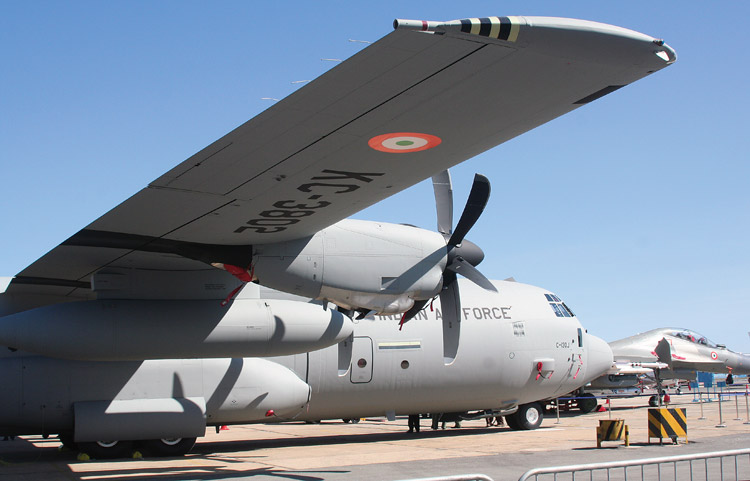- Prime Minister Narendra Modi inaugurates Aero India 2023 in Bengaluru; Releases Commemorative Stamp
- Defence Secretary meets delegations from Saudi Arabia, USA and Oman on the sidelines of Aero India 2023
- Foreign Ministers of 32 countries to attend Aero India 2023
- Embraer showcases the C-390 Millennium at Aero India 2023
HISTORY REVISITED: Lockheed Martin C-130 to C-130J Super Hercules

Year 1951, the US Air Force was seeking designs for an aircraft capable of hauling large bulky equipment, including artillery pieces and tanks, over long distances. It had to land in tight spaces, slow to 125 knots for paratroop drops, and fly, if need be, with one engine. What the Air Force wanted, in other words, was a tough, versatile heavy-lifter with plenty of "trunk" space.
Hall Hibbard, Lockheed's Chief Engineer, eyed the request and saw the potential. Design genius Kelly Johnson, by contrast, viewed it as a potential disaster, a diversion from the high-speed, high-performance jet fighters that were his focus.
"If you send that in," Johnson told his boss, Hibbard, referring to an early proposal for the aircraft, "you'll destroy the Lockheed Company." Hibbard didn't listen. When the prototype YC-130 taxied for its inaugural flight on August 23, 1954, it was clear to all-even Johnson- that the Lockheed engineers had forged something timeless out of a seemingly simple list of Air Force requirements. Later officially nicknamed Hercules, the prototype had a cargo deck that was capable of carrying an astonishing 300 pounds per square foot, lifted into the air after a ground roll of a mere 855 feet, an astoundingly short distance considering that most aircraft of that size required 5,000 feet.
BUILDING THE HERK
The creation of the C-130 Hercules came about largely as a result of America's experience in the Korean War. The US forces fighting along the 38th Parallel dividing North and South Korea quickly discovered that their aerial transports were ill-equipped for the missions at hand. Some were too heavy. Some needed longer runways for take-offs and landings. What the US military needed was a single versatile aircraft that could be used for any and all transportation needs-one aircraft that would perform the role of many and which is precisely what Lockheed's Hercules accomplished.
With a sweeping array of 23 cockpit windows allowing for clear visibility on steep approaches and high wings to operate from rough fields, the original C-130 Hercules was the antithesis of the sleek, speedy jets of its day. It had a low centre of gravity, reached 575 kmph, and boasted a large, easily accessible cargo area that could carry 40,000 pounds. But it was a key design element- instituted by a team that included Art Flock, Dick Pulver, Bill Statler, Gene Frost, and Chief Designer Willis Hawkins-that may have proven most useful for its longevity. The inclusion of four turboprop engines provided surplus power to pressurise the fuselage of the plane, including the cargo compartment, which was necessary to fly efficiently at higher altitudes.
WAR BIRD
The C-130 was pressed into action in Vietnam, where it picked up and dropped off troops and supplies in the most remote of locations. The C-130s are equipped to carry out low-altitude parachute extraction drops of cargo, which led to the plane's key role in the defence of Khe Sanh in 1968, when C- 130s accounted for 90 per cent of the supplies used by troops defending the village from a North Vietnamese siege. As the war progressed, C-130s were modified into MC-130 Combat Talons, which not only picked up special operations forces in hostile territories but acted as flying gas tankers, orbiting in the sky as American rescue helicopters docked with them to refuel. Three decades later, Marine Corps KC-130J tankers were being fitted with missiles so crews could take out hostile targets on the ground in Afghanistan.
LIFESAVERS
For more than three generations, the C-130 has been there to help during devastating humanitarian crises. The people of the Congo, Somalia, Bosnia, Rwanda, Kosovo, Japan, and points all over the world, including New Orleans after Hurricane Katrina, have all benefited from the C-130's unparalleled delivery and air-drop capabilities, whether they were acting as a flying hospital or delivering hay to cows marooned by a snowstorm. Equipped with skis and Teflon-coated runners, the durable aircraft has earned great respect for safely delivering supplies deep into Antarctica or to the Greenland ice cap.
HURRICANE HUNTERS
The C-130-the latest C-130J Super Hercules in particular-is the airplane of choice for the Air Force Reserve Command's weather reconnaissance squadron, known as the Hurricane Hunters. They fly their WC-130Js straight into the eye of hurricanes, travelling from the outskirts of the storm to its centre and then out again. Perhaps most amazing is the fact that since 1974, no WC-130 aircraft flown by the Hurricane Hunters have been lost. That safety and performance record is a testament to their skill, and an example of the toughness of a 60-year-old Lockheed design that shows no sign of slowing down.





